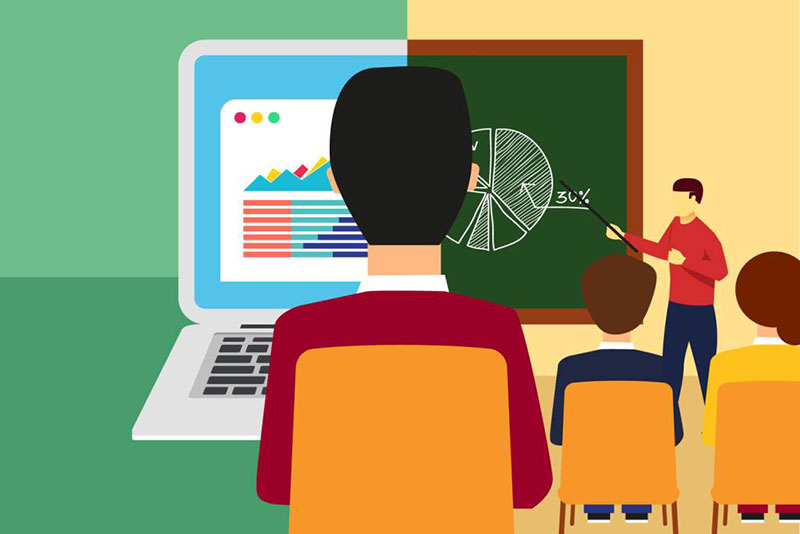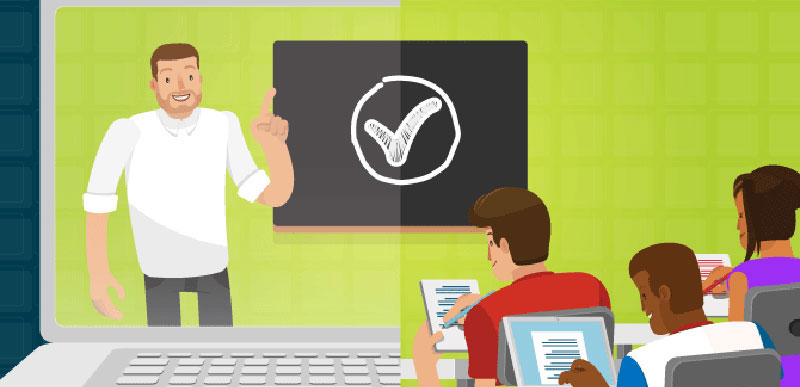Blended Learning: How your school can combine online and offline teaching
The first time we talked about blended learning here, a few years ago, the idea was new and little known.
Now, this learning method has already established itself as one of the most important trends for 21st century education.

Blended Learning: what it is and what its importance for education
Blended learning, also known as b-Learning, is a combination of offline and online instruction where students interact with the instructor, the material, and other students through both a physical classroom and an online platform.
Also known as semi-presential education, this is understood as a type of fusion between traditional education and modern methodology that uses technology.
Defining exactly what Blended Learning is can be quite complicated, as it is a comprehensive term. Currently, one of the most accepted definitions by scholars is the following:
“A teaching method to which you integrate technological as well as virtual activities in conjunction with traditional teaching, using planned activities that have a pedagogical value.”
It is important to highlight its hybrid concept, that is, a methodology that adequately aggregates teaching by technological means, without replacing, but integrating with the traditional format.
Blended Learning uses technology not only to supplement, but to transform and improve the learning process.
Since Internet access increased and Distance Education emerged and began to consolidate, educators and school administrators realized the importance of seeking more innovative teaching models.
The goal is to meet the needs of new generations of students for a more efficient, interesting, personalized education and connected with this reality in which technology is part of everyday life.
The great advantage of blended learning is that it offers “the best of both worlds” – that is, the advantages of online education combined with all the benefits of the traditional classroom.
– 8 things you need to know about online education
A specialist who has helped in the dissemination of these practices, Michael Horn says he considers that blended learning is the only way to promote the transformation in education networks.
“Blended Learning opens up space for teamwork and the development of critical thinking like never before,” he said.
He further stresses that this approach is able to offer students both knowledge and opportunity to develop the skills you will need to be successful in life.
Online Courses and Blended Learning
Blended learning presents itself as a solution that mixes two possibilities of education and allows the teacher to experiment and increase his results.
At Coursify.me we have courses in this format that have been quite successful.
We observe professionals who mix online modules with face-to-face classes, or create an online course as support material for the classroom teaching, such as the example below:
https://farazs-web-development-school.coursify.me/
This combination of methodologies also contributes to another change in education that has been debated in recent years: the flipped learning.
Flipped learning: evolution in education
Flipped learning is a teaching methodology that makes the student protagonist in his own learning, promoting an active, investigative and collaborative learning.
In this model, the student studies a certain topic at home, with the help of technology, and goes to the classroom prepared to debate, discuss his doubts, contribute with ideas and thus exercise an active role in the classroom, being a transmitter of knowledge, not just a receiver.
Scholars have long advocated the positioning of the student as the protagonist of the class, learning more autonomously, with the support of technology, to optimize the effectiveness of education.
Disseminated in recent years by professors Jon Bergmann and Aaron Sams, the flipped class methodology has achieved positive results, having been tested and approved by universities like Duke, Stanford and Harvard.
Despite the concept being considered an innovation, big names in education already talked about the importance of this form of active learning before.
We must remember, for example, that Paulo Freire was adept at having the teacher transform the class into an interactive environment, using resources such as videos and television.
“We don’t have to end school,”he said in a dialogue with Papert in 1996, “but rather to change it completely until a new being as current as technology is born.”
Unfortunately, the change is slow, but some schools and universities are already doing this and, soon, we may see surprising results.
Meanwhile, blended learning and distance education continue to escalate, proving their benefits for a future reality that, we all hope, will bring concrete and positive changes to education.
Advantages of Blended Learning for schools and students

Many debates have been made around the advantages and disadvantages of this method, and whether it is better or not than classroom teaching.
As with e-Learning, the best conclusion reached was that it is not necessary to define whether one is superior to the other, both have their positive points and can be used together.
It should always be remembered that not all students learn in the same way, some are more visual and auditory, while others are more practical, needing to interact and perform activities to be able to assimilate the content.
Mixing online and offline teaching, it is possible to take advantage of both methodologies, among which the following stand out:
- Greater time flexibility;
- Decreases the need for mobility;
- Decreases costs;
- It promotes integration among participants, with a consequent exchange of experiences;
- Enables the development of collective dynamics;
- Facilitates student assessment;
- Enables field work and visits to places of interest;
- Better learning results through the use of more diverse means of information.
Teachers who want to start exploring the potential of online teaching can choose as a starting point mixed course, using online classes to reinforce the content taught in the classroom.
Blended Learning in Brazil
In Brazil, blended learning is widely used in higher education with subjects taught through distance learning.
In 2016, Positivo University (UP) launched its first three undergraduate courses in the hybrid mode: Physical Education, Pedagogy and Gastronomy.
“We need to meet the needs of society, the work market and these students, who learn in a very different way than we learned ten years ago. Today, we already have a group of professors at the university who work with active methodologies and who increasingly integrate the technologies with the classroom. The objective of the hybrid courses is to train professionals capable of developing leadership skills, problem solving and technologically connected with a changing world ”, says the academic dean of UP and director of the Brazilian Association for Distance Learning (Abed), Carlos Longo.
According to Longo, the acquisition of information can happen through a dynamic Learning Management System (LMS), with e-book, games and video lessons.
– Whats is a Learning Management System
In addition, tuition fees are up to 30% lower, and may even serve residents of other cities and contribute to reducing the number of 15 million adults between 25 and 30 years of age who do not yet have a college degree in Brazil.
Distance Learning in the face of the COVID-19 crisis
Since the pandemic caused by COVID-19 spread around the world, dozens of schools have been using eLearning as a way to maintain classes, since all face-to-face activities have been banned.
In this scenario, institutions that were already familiar with some concepts of blended learning and mixed teaching in the classroom with technological activities, took the lead.
– Tips for using eLearning in school education
With no deadline to end, social isolation as a way of flattening the virus contagion curve continues, forcing schools to quickly adapt to online education.
The demand for eLearning learning platforms for hosting online classes has grown all over the world.
– What is an e-Learning platform
There are already several elementary and high schools offering access to classes within online platforms, in an attempt to continue education and prevent the school year from being lost.
However, aware that many students and their families still do not have access to computers and a stable internet, blended learning is the best solution to guarantee the right to education for all.
What many schools have tried to do is use online means to pass practical activities, which students can develop at home, within their routine.
Thus, long theoretical classes, which would be unfeasible for elementary school children, whose attention is very difficult to maintain for a longer period of time, are avoided, giving preference to activities based on experimentation.
While education officials debate what to do if isolation recommendations continue, each school looks for a solution and runs to adapt its classes to the digital format.
– Step by Step to Create Online Courses
Digital School at Coursify.me

A complete and ready-to-use Learning Management System, Coursify.me has been hosting several elementary and high schools.
A good example is the Chapeuzinho Vermelho school, which created its digital school and managed to take its classes to each student’s home:
https://chapeuzinhovermelhodigital.coursify.me/
With all the necessary resources to enable and facilitate online learning, the platform has a friendly and fully customizable interface, allowing each school to maintain its visual identity, facilitating student recognition.
The Coursify.me features integration with other content platforms such as YouTube and Vimeo, which is ideal for teachers who want to provide lessons in videos.
– Learn how to record videos at home
In addition, users can upload videos, texts, images, audios and any other material that is hosted on Dropbox or on their own computer.
There is no limit on the number of students allowed, and the school has full control over who has access to the classes, being able to monitor each student, to find out who registered, attended the classes and fulfilled the activities sent.
Attending schools, businesses and professionals in more than 60 countries, the platform is a dynamic Learning Management System, ready to serve you.
Visit our website, test the platform and invest in blended and distance learning to continue educating your students in the best possible way.

